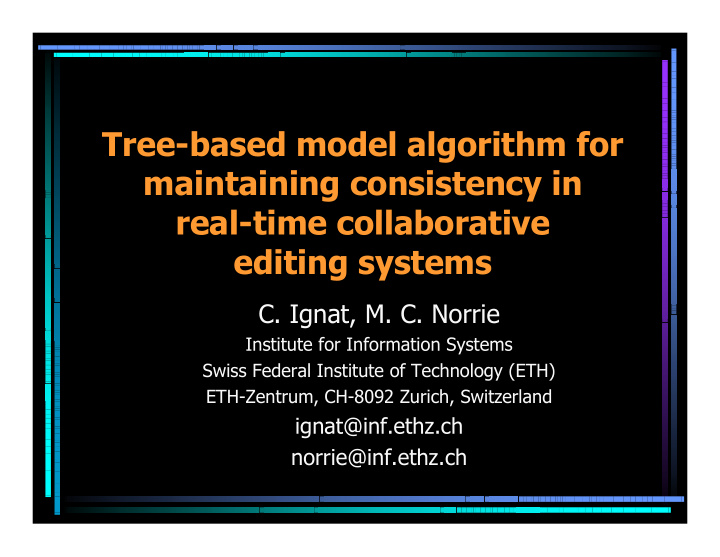



Tree-based model algorithm for maintaining consistency in real-time collaborative editing systems C. Ignat, M. C. Norrie Institute for Information Systems Swiss Federal Institute of Technology (ETH) ETH-Zentrum, CH-8092 Zurich, Switzerland ignat@inf.ethz.ch norrie@inf.ethz.ch
Outline � Consistency Maintenance in Real-time Collaborative Editing Systems � Operational transformation algorithms � Motivation for a New Algorithm � The treeOPT Algorithm � Main characteristics � Proposed document structure � Functioning � Future Work � Conclusions
Consistency Maintenance in Real-time Collaborative Editing Systems � Real-time collaborative editing systems Groupware systems that allow members of a team to simultaneously edit shared documents from different sites � Operational transformation dOPT, adOPTed, GOT, GOTO, SOCT2, SOCT3, SOCT4
Motivation(1) � Existing algorithms – linear representation of the document A single history buffer � large number of transformations (low efficiency, response-time) � all operations “interfere” with each other => we need an algorithm that reduces the no. of transformations, operations at completely different positions not interfering with each other
Motivation(2) � Existing algorithms – enforce syntactic consistency , not semantic consistency � Example 1 (working at character level): Initial document: “Helo everybody.” � First user: inserts an “l” “Hello everybody.” � Second user: deletes “Helo” and writes “Bye” “Bye everybody.” There is no semantically correct way to solve the conflict automatically Algorithms may obtain “Byel everybody.”
Motivation(3) � Example 2 (working at word level) Initial document: “The child go alone to school.” � First user: deletes “go”, inserts “goes” “The child goes alone to school.” � Second user: inserts “can”. “The child can go alone to school.” Result : “The child can goes alone to school.” => we need an algorithm that addresses semantic consistency , by allowing users to work at coarser (and selectable) granularity
New Algorithm - Characteristics � Supports a hierarchical structure of the document Document Pa 1 Pa 2 Pa n … … … Se 1.1 … Se 1.m W 1.1.1 W 1.1.p … … C 1.1.1.1 C 1.1.1.q … … � Improves efficiency � Allows working at any level of granularity paragraph, sentence, word, character � Step towards semantic consistency
Proposed document structure History for operations at Document paragraph level Pa 1 Pa 2 Pa 3 Document History History for operations on sentences in Se 3.1 Se 3.2 Pa3 History … … paragraph Pa3 … W 3.1.1 W 3.1.2 W 3.1.3 Se 3.1 History History for operations on words in sentence … … Se3.1 C 3.1.2.1 C 3.1.2.2 C 3.1.2.3 W3.1.2 History “C” “A” “R” History for operations on characters in word W3.1.2
Structure of a node Node – a structure of the form: N = {level, children, length, history, content} � level – granularity level, level , {0,1,2,3,4} � children – ordered list of nodes {child 1 ,…child n } level(child i ) = level + 1 , for all i ∈ {1,..n} = 1 , if level 4 � length - n ∑ length ( child ), otherwise i = i 1 < undefined , if level 4 � content - = aCharacter , if level 4
Structure of a Composite Operation � Composite operation - a structure of the form cOp = {level, type, position, content, statevector, initiator} � level - granularity level, level , {1, 2, 3, 4} � type - type of the operation, type , {Insertion, Deletion} � position - vector of positions position[i] = position for the i th granularity level, i , {1, ..., level} � content - a node, representing the content of the operation � statevector - state vector of the generating site � initiator –initiator site identifier � Example: cOp(2, Insertion, [3,1,x,x], sentence, statevector) an insertion of the sentence given by node “ sentence ”, timestamped by “ statevector ”, in paragraph 3, as sentence 1 in the paragraph
The treeOPT Algorithm – Functioning (1) � Example – a site receives the remote operation InsertWord (3,1,3,” love ”); Document Pa 1 Pa 2 Pa 3 Document History Se 3.1 Se 3.2 Pa3 History W 3.1.1 W 3.1.2 W 3.1.3 Se 3.1 History Word “love” “ love” “l” “o” “v” “e” Empty History
The treeOPT Algorithm – Functioning (2) � A concurrent operation inserts a paragraph Document Document New Pa 1 Pa 2 New Pa4 Document History Pa 1 Pa 2 Pa 3 Document History Se 4.1 Se 4.2 Pa4 History Se 3.1 Se 3.2 Pa3 History W 4.1.1 W 4.1.2 W 4.1.3 Se 4.1 History W 3.1.1 W 3.1.2 W 3.1.3 Se 3.1 History “ love” InsertWord (3,1,3,” love ”) => InsertWord (4,1,3,” love ”) � We apply the algorithm for all granularity levels, beginning with paragraph level, and ending with level of the operation
Use of the Algorithm � The algorithm works with any existing concurrency control algorithm relying on a linear document structure � We tested the operation of the algorithm when combined with the GOT algorithm, and the corresponding undo/do/redo scheme
Future Work � Adapting the algorithm for a graphical editor � Locking at different granularity levels � Social aspects (audio communication, chat systems) � UIP (Universal Information Platform) project
Conclusion � treeOPT is a consistency maintenance algorithm relying on a tree representation of the document and applying the operational transformation mechanism over different document levels � Increases efficiency � Provides means to enforce “semantic” consistency � Allows flexibility of granularity
Recommend
More recommend